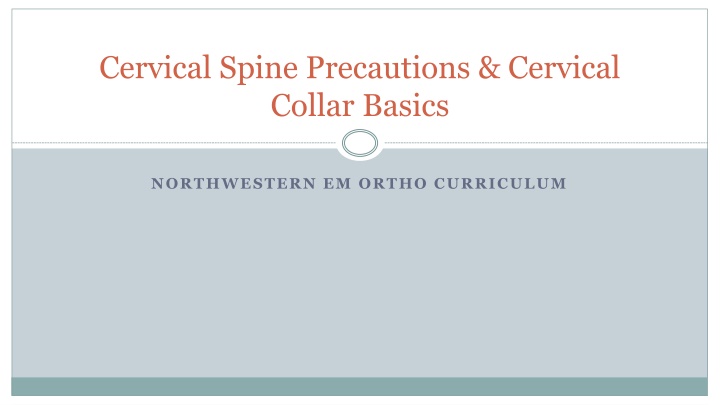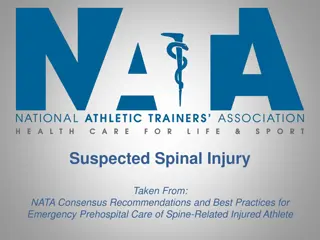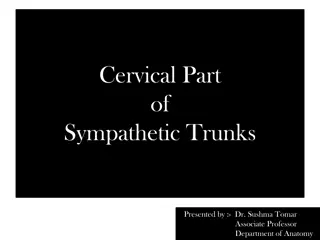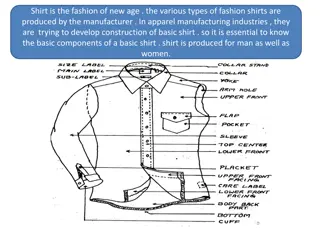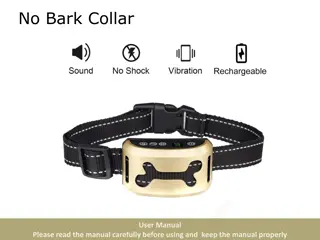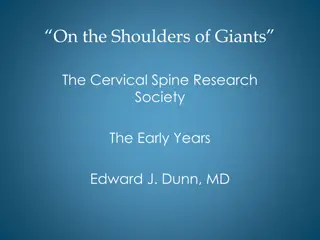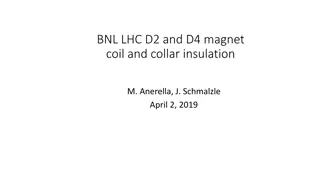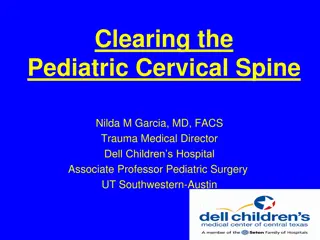Cervical Spine Precautions & Cervical Collar Basics
Cervical collars, also known as C-Collars, are medical devices worn around the neck to support and immobilize the cervical spine. They are commonly used after trauma or surgery. Trauma patients with blunt traumatic injuries may benefit from C-Collar placement based on clinical judgment. It is important to consider indications and precautions for proper placement to avoid complications and ensure patient safety.
Download Presentation

Please find below an Image/Link to download the presentation.
The content on the website is provided AS IS for your information and personal use only. It may not be sold, licensed, or shared on other websites without obtaining consent from the author.If you encounter any issues during the download, it is possible that the publisher has removed the file from their server.
You are allowed to download the files provided on this website for personal or commercial use, subject to the condition that they are used lawfully. All files are the property of their respective owners.
The content on the website is provided AS IS for your information and personal use only. It may not be sold, licensed, or shared on other websites without obtaining consent from the author.
E N D
Presentation Transcript
Cervical Spine Precautions & Cervical Collar Basics NORTHWESTERN EM ORTHO CURRICULUM
What is a Cervical Collar (C-Collar)? A medical device worn around the neck to support and immobilize the cervical spine Also known as a neck brace Frequently worn after trauma, surgery, or for acute pain Examples: Semi-rigid trauma collar Inexpensive (~$10), common, easily adjustable Common brand names: Ambu, Laerdal Cushioned, sizable cervical collar Increased comfort and lower risk of skin breakdown with long-term wear, multiple sizes, costlier (~$50-100) Common brand names: Aspen Vista, Ossur Miami J Soft collar Not an immobilization device For patient comfort, avoid long-term use to avoid worsening stiffness & muscle atrophy
Initial Considerations for C-Collar Placement Trauma Not routinely recommended for neurologically intact patients with penetrating trauma Currently recommended for some patients with blunt traumatic injury Emergency Medical Services (EMS) will likely place a c-collar +/- rigid backboard on any patient presenting immediately after a blunt traumatic injury with significant mechanism Rigid backboards are for transport only and should be removed on arrival to the ED Cause discomfort and can lead to skin breakdown fairly quickly if not removed Additional items also used by EMS, such as tape and blocks around the head and neck, can be also be removed by clinicians in ED
Indications for C-Collar Placement Best practices and indications for c-collar placement on individual patients are debated and require best judgment by a trained clinician based on the clinical situation In general, if a c-collar is not placed in the field or a patient is brought in by private vehicle, a clinician should use clinical judgment and consider applying to the following patient populations: Patients with a neurologic deficit on exam Patients suffering from blunt trauma and with: Unstable vitals signs Altered mental status (GCS 14) Evidence of facial or neck injuries Significant neck pain Inability to complete neurologic exam based on patient factors (intoxication, altered mental status) Advanced age or frailty (as determined by physician discretion) Patients who arrive ambulatory, neurologically intact, without c-collar in place, or those who have delayed presentations after traumatic injury are unlikely to benefit from c-collar placement
Technique for C-Collar Placement If possible, have two clinicians available for placement one to hold in-line stabilization of the cervical spine and one to apply the collar Patient will be lying flat on a bed and/or board If an adjustable collar is used, the most inferior portion of the collar should lie flush with the upper chest and the most superior portion will be tight against the chin Instruct patient not to move their head Press down on the cushioning of the bed on one side of the patient s neck Use the space created to slide through the posterior flap of the c-collar Flip out the chin rest and bend the anterior flap of the c-collar around the patient s neck this step is frequently forgotten, resulting in the collar digging into the patient s chin Tighten the Velcro strap for snug fit
Mobility for a Patient with Suspected Cervical Spine Injury Have at least three people available to assist Instruct patient not to move Have trained clinician hold inline immobilization of the cervical spine Recommendation: Person at head of bed, who is holding inline stabilization, should count out loud ( 1,2,3 ) to help coordinate synchronized log roll and patient transfer Have two additional clinicians turn the patient utilizing log roll technique Hard backboard can be removed when patient is on their side Patients often feel like they are falling when board is removed, warn them of this ahead of time During a trauma workup/secondary survey, this technique can be used to facilitate examination of the back and palpation of the thoracic and lumbar spine Place patient on a flexible backboard for transfers, remove once transfer is complete Return patient to lying position with synchronized, slow lowering Head of bed can again count out load to coordinate this movement Log roll technique Transfer using backboard
Inline C-Spine Stabilization during Intubation The first step in management of trauma patients is assessing and securing their airway This may require endotracheal intubation Studies have shown that it is more difficult to successfully intubate a patient wearing a rigid c- collar Removal of the c-collar and manual in-line stabilization (MILS) is recommended to increase chance of successful intubation There are two most common techniques Both require a second clinician, who: Crouches next to the patient and intubating clinician, holding the occiput on both sides of the head Stands facing the intubating clinician, holding forearms against the patient s chest with fingers extending to both sides of the head
Cervical Spine Clearance and C-Collar Removal How? Use clinical decision rules Canadian C-Spine Rule (CCR) NEXUS Obtain imaging, if necessary CT cervical spine without contrast If positive imaging findings: Remain in c-collar with precautions Involve consultants If negative imaging and resolved pain: Remove c-collar
C-Collar Removal for Patient with Persistent Pain Persistent c-spine tenderness after negative imaging is a common issue in trauma patients One study suggested a majority of patients without reported head or neck trauma will have midline cervical spine tenderness Recommendations for management in this patient population vary, with the majority of societies suggesting one of the following: Obtain MRI cervical spine Discharge patient in cervical collar and set up follow-up in two weeks Clear cervical spine and remove collar if negative CT imaging, even with persistent pain Because of the lack of consensus in best clinical practice, nearly every trauma center has guidelines for management of these patients Clinicians should consult their institutional guidelines and use best clinical judgment in this patient population
References Sources: Buck A, Colwell C. The Great C-Collar Debate. EM:RAP. https://www.emrap.org/episode/januaryhotsheet/thegreatccollar. Published January 1, 2017. Accessed December 13, 2022. Cervical Spine Packet. Henry Mayo. https://www.henrymayo.com/. Published November 1, 2015. Accessed December 13, 2022. Coffey F, Hewitt S, Stiell I, et al. Validation of the Canadian c-spine rule in the UK emergency department setting. Emerg Med J. 2011;28(10):873-876. doi:10.1136/emj.2009.089508 Deasy C, Cameron P. Routine application of cervical collars--what is the evidence?. Injury. 2011;42(9):841-842. doi:10.1016/j.injury.2011.06.191 Delaney JS, Al-Kashmiri A, Alalshaikh A, Al-Ghafri S, Saluja SS, Correa JA. Prevalence of midline cervical spine tenderness in the non-trauma population. Emerg Med J. 2022;39(4):308-312. doi:10.1136/emermed-2021-211288 Hoffman JR, Mower WR, Wolfson AB, Todd KH, Zucker MI. Validity of a set of clinical criteria to rule out injury to the cervical spine in patients with blunt trauma. National Emergency X-Radiography Utilization Study Group [published correction appears in N Engl J Med 2001 Feb 8;344(6):464]. N Engl J Med. 2000;343(2):94-99. doi:10.1056/NEJM200007133430203 Kwan I, Bunn F, Roberts I. Spinal immobilisation for trauma patients. Cochrane Database Syst Rev. 2001;2001(2):CD002803. doi:10.1002/14651858.CD002803 Orman R, Colwell C. Do we still need the C-collar? EM:RAP. https://www.emrap.org/episode/feb2016emrap/dowestillneed. Published February 6, 2016. Accessed December 13, 2022. [Peer-Reviewed, Web Publication] Levine, D. Schmitz, Z. (2021, Oct 18). C-Spine. [NUEM Blog. Expert Commentary by Levine, M]. Retrieved from http://www.nuemblog.com/blog/cervical-spine-intubation Stiell IG, Clement CM, O'Connor A, et al. Multicentre prospective validation of use of the Canadian C-Spine Rule by triage nurses in the emergency department. CMAJ. 2010;182(11):1173-1179. doi:10.1503/cmaj.091430 Stiell IG, Wells GA, Vandemheen KL, et al. The Canadian C-spine rule for radiography in alert and stable trauma patients. JAMA. 2001;286(15):1841-1848. doi:10.1001/jama.286.15.1841 Tienpratarn W, Yuksen C, Aramvanitch K, et al. Success Rate of Endotracheal Intubation Using Inline Stabilization with and without Cervical Hard Collar; a Comparative Study. Arch Acad Emerg Med. 2020;8(1):e81. Published 2020 Oct 10. Tran J, Jeanmonod D, Agresti D, Hamden K, Jeanmonod RK. Prospective Validation of Modified NEXUS Cervical Spine Injury Criteria in Low-risk Elderly Fall Patients. West J Emerg Med. 2016;17(3):252-257. doi:10.5811/westjem.2016.3.29702 Vaillancourt C, Charette M, Sinclair J, et al. Implementation of the Modified Canadian C-Spine Rule by Paramedics [published online ahead of print, 2022 Oct 31]. Ann Emerg Med. 2022;S0196-0644(22)01030-7. doi:10.1016/j.annemergmed.2022.08.441 Velopulos CG, Shihab HM, Lottenberg L, et al. Prehospital spine immobilization/spinal motion restriction in penetrating trauma: A practice management guideline from the Eastern Association for the Surgery of Trauma (EAST). J Trauma Acute Care Surg. 2018;84(5):736-744. doi:10.1097/TA.0000000000001764 Images and Videos: https://meditackits.com/products/ambu-perfit-ace-adjustable-collar?variant=42644348403965¤cy=USD&utm_medium=product_sync&utm_source=google&utm_content=sag_organic&utm_campaign=sag_organic&gclid=CjwKCAiA- dCcBhBQEiwAeWidtd2NyM_Rk7KUuJE1djAr0hCt8uc5te8y1SvhCEn_XX8XuGYVHiCbUhoCgeoQAvD_BwE https://www.alimed.com/aspen-collars.html https://veteriankey.com/prehospital-immobilization/ https://www.youtube.com/watch?v=tzobASnovRc https://clinical.stjohnwa.com.au/clinical-skills/trauma/spinal-precautions-immobilisation/log-roll https://www.mascip.co.uk/wp-content/uploads/2015/02/MASCIP-SIA-Guidelines-for-MH-Trainers.pdfd https://www.mdcalc.com/calc/696/canadian-c-spine-rule#use-cases https://www.mdcalc.com/calc/703/nexus-criteria-c-spine-imaging https://doctorlib.info/pediatric/schafermeyers-pediatric-emergency-medicine/24.htm
